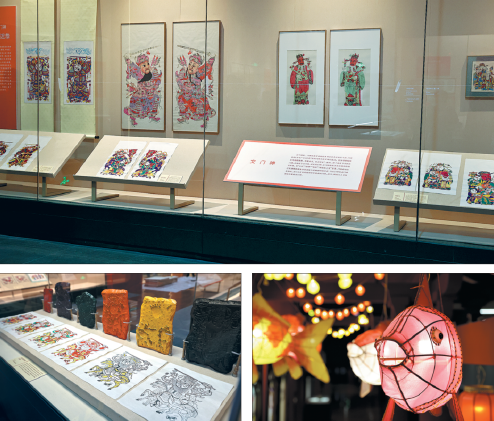Exhibition frames New Year pictures
Guangdong Museum explores images and reason behind activity associated with ushering in a fresh era, reports Li Wenfang in Guangzhou.

As Spring Festival approaches, the ongoing exhibition of traditional Chinese New Year pictures at the Guangdong Museum provides an artistic and cultural angle for understanding this important event.
Traditionally, New Year pictures are acquired and displayed in homes and other places to celebrate Chinese New Year.
The more than 300 pictures, and woodblocks used for making such pictures, at the exhibition come from museums and publishers in Foshan, Guangdong province; Taohuawu in Suzhou, Jiangsu province; Yangjiabu village in Weifang, Shandong province; Zhuxian town in Henan province; Mianzhu, Sichuan province; Wuqiang county, Hebei province and Tianjin's Yangliuqing township.
Among them, the history of New Year pictures from Zhuxian town in Henan province can be traced back to Kaifeng, the then capital of the Northern Song Dynasty (960-1127).
New Year pictures mostly reached their peak during the Qing Dynasty (1644-1911) in the aforementioned places that have contributed exhibits.
The exhibition at the Guangdong Museum in Guangzhou, Guangdong province, is themed on immortals, people, life and customs, and legends.
Traditionally, the preparations for celebrating the New Year start in the 12th lunar month. Late in the month, the picture of zaoshen, the kitchen god, is displayed in the cooking area for good luck in the new year, according to the organizer of the exhibition.
On Lunar New Year's Eve, pictures depicting menshen, or door gods, appear on front doors to guard the house from evil spirits. Door gods were initially pictured in a military style, but started to also feature figures resembling civil officials during the Ming Dynasty (1368-1644).In the Ming and Qing dynasties, celestial beings and auspicious animals also found a position on the door.
When the new year descends, images depicting gods of luck, fortune, longevity, happiness and wealth adorn houses.
Figures with a sacred status that also appear in the New Year pictures can include saints and immortals from Confucian, Buddhist and Taoist beliefs, as well as a number of "gods" that oversee various areas of life and business.
Among them, Zhong Kui, who is a mythological demon-killer, and Guan Yu, a general in the late Eastern Han Dynasty (25-220), who was later elevated to divine status following the Song Dynasty (960-1279), are famous examples.
Besides figures in human form, animals deemed auspicious also have a place in New Year pictures, including the dragon, tiger, deer, crane, goat, monkey, lion and cat. For example, a picture featuring the cat and butterfly expresses a wish for longevity, because maodie, or the names of the two animals (mao meaning cat and die meaning butterfly) joined together, is a homophone of the word pertaining to very old age — from 80 to 90. Additionally, the cat, by catching the mouse, guards the grains, and the silkworm that produces the materials for textile products.
Mortals followed divine figures, and began to appear in the New Year pictures, as people paid more attention to their own lives and development.
During the Ming and Qing dynasties, many such pictures depicted beautiful women living a desirable life. In the pictures, they can be seen visiting quiet, natural surroundings, or staying in an exquisite room. They are often pictured doing embroidery, playing a musical instrument or chess, painting, nurturing children or enjoying some form of performance.
The most memorable New Year pictures, however, are perhaps those featuring one or more cherubic babies, often depicted holding a big fish, which express the hope of having a large family. Fish and lotus flowers in those pictures both have auspicious connotations.
New-style New Year pictures were first created in the liberated areas during the War of Resistance Against Japanese Aggression (1931-45) in line with the political, military and economic needs.
After the People's Republic of China was founded in 1949, and with the support of the Ministry of Culture, more new-style works were created, alongside the more traditional themes. The new-style works cover themes on industrial and agricultural work, unity of the army and the people, healthcare and children's education.
In the 1980s, art publishers started to move away from their New Year picture business to other, more lucrative, sectors.
The third part of the exhibition focuses on New Year pictures that highlight traditional festivals, people's daily work, four seasons and current affairs.
Pictures featuring scenery and places of interest drew on traditional Chinese painting techniques and showed the influence of the Western artistic technique of linear perspective.
Flowers, birds, plants and insects, which were themes in traditional Chinese paintings, also featured in New Year pictures, often joined by auspicious elements.
In the final part of the exhibition, visitors can see historical figures and events, legends, as well as scenes and actors from traditional Chinese operas, in New Year pictures, with some being produced in a serial form.
During the late Qing Dynasty, and from the early 1910s to '40s, news-themed New Year pictures appeared, as novel things kept emerging during those turbulent times.
Alongside the pictures, the technique for making such pictures, which includes woodblock printing and a combination of woodblock printing and painting, are also displayed. The exhibition will run until March 29.

Today's Top News
- China steps up efforts to boost opening-up
- World's highest bridge passes stress test
- China scales up network to fuel growth of AI
- Ancient bronze casting art decoded
- Shenzhen SEZ to continue spearheading reform and opening-up
- War sacrifices never to be forgotten































